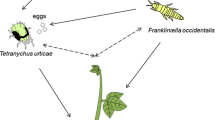Abstract
The predatory behaviour of three reduviids, the millipede-feedingHaematorrhophus nigroviolaceus (Reuter) (Ectrichodiinae), the insectivorousPirates affinis Serville (Piratinae) and the haematophagousTriatoma rubrofasciata (De Geer) (Triatominae), both under natural and laboratory conditions, is discussed. Visual stimuli elicited by the moving prey appear important for the initiation of feeding response. The olfactory stimuli from the defensive secretions of the prey appear to enhance the response and help in the continuation of feeding. In the haematophagousTriatoma rubrofasciata, while feeding responses are elicited only by the temperature gradient around their vertebrate hosts, the visual and olfactory senses play only a minor role. On the basis of observations on feeding behaviour, appropriate predatory behaviour models for the three reduviid species have been constructed.
Similar content being viewed by others
References
Anuzel R 1972 The structure and properties of an abdominal stretch receptor inRhodnius prolixus Stal (Hemiptera-Reduviidae);J. Insect Physiol. 18 2143–2153
Bernard J, Pinet J M and Boistel J 1970 Electrophysiologie des recepteur des stylets maxillaire deTriatoma infestans action de la temperature et de la teneur en eau de l’air;J. Insect Physiol. 16 2157–2180
*Cachan P 1952 Etude de la predation chez les reduvides de la region ethiopienne 1. La predation en groupe chezEctrichodia gigas H. Sch.;Physiol. Comp. Oecol. 2 378–395
Edwards J S 1962 Observations on the development and predatory habits of two Reduviid Heteroptera,Rhinocoris carmelita Stal andPlatymer is rhadamanthus Gerst.;Proc. R. Ent. Soc. London A37 89–98
Eisner T 1958 The protective role of the spray mechanism of the bombardier beetle,Brachynus ballistarius Lec.;J. Insect Physiol. 2 215–220
*Eisner H E, Eisner T and Hurst J J 1963a Hydrogen cyanide and benzaldehyde produced by millipedes;Chem. Ind. 1963 124–125
Eisner T, Hurst J J and Meinwald J 1963b Defence mechanism of Arthropods: XI The nature, function, and phenolic secretions of a chordeumoid millipede and a carabid beetle;Psyche 70 94–116
Eisner T, Swithenbank C and Meinwald J 1962 Defence mechanisms of Arthropods VIII. Secretion of salicylaldehyde by a carabid beetle;Ann. Ent. Soc. Am. 56 37–41
Friend W G and Smith J J B 1977 Factors affecting feeding by blood sucking insects;Ann. Rev. Entomol. 22 309–331
* Green W E 1925 Presidential address;Trans. Ent. Soc. London, clxi–ccii
Haridass E T 1978 Biological and ethological studies on some South Indian Reduviids (Hemiptera—Reduviidae); Ph.D. Thesis, University of Madras, Madras
Hoare C A 1972The trypanosomes of mammals (Oxford and Edinburgh. Blackwell Scientific Publications) pp. 779
Louis D and Kumar R 1973 Morphology of the alimentary and reproductive organs in Reduviidae (Hemiptera—Heteroptera) with comments on interrelationships within the family;Ann. Ent. Soc. Am. 66 635–639
Maddrell S H P 1963 Control of ingestion inRhodnius prolixus Stal;Nature (London) 198 210
Miller N C E 1971The biology of Heteroptera; (England E W Classey Ltd.) (2nd ed.), pp. 206
Odhiambo T R 1958 Some observations on the natural history ofAcanthaspis petax Stal (Hemiptera—Reduviidae) living in termite mounds in Uganda;Proc. R. Ent. Soc. London A33 167–175
Parker A H 1965 The predatory behaviour and life history ofPisilus tipuliformis Fab. (Hemiptera—Reduviidae);Entomol. Exp. Appl. 8 1–12
Parker A H 1969 The predatory and reproductive behaviour ofRhinocoris bicolor andR. tropicus (Hemiptera—Reduviidae);Entomol. Exp. Appl. 12 107–117
Parker A H 1971 The predatory and reproductive behaviour ofVestula lineaticeps (Sign.) (Hemiptera—Reduviidae);Bull. Ent. Res. 61 119–124
Parker A H 1972 The predatory and sexual behaviour ofPhonoctonus fasciates (P et B) andP. subimpictus Stal (Hemiptera—Reduviidae);Bull. Ent. Res. 62 139–150
Pinet J M 1968 Donnees ultrastructurales sur l’innervation sensorielle des stylets maxillaires desRhodnius prolixus Stal;C.R. Acad. Sci. Paris 267 634–637
Roth L M and Eisner T 1962 Chemical defenses of Arthropods;Ann. Rev. Entomol. 7 107–136
Ryckman R E 1951 Recent observation on the cannibalism inTriatoma (Hemiptera—Reduviidae)J. Parasitol. 37 433–434
Ryckman R E 1952 Laboratory culture of Triatominae with observations on behaviour and a new feeding device;J. Parasitol. 38 210–214
Wigglesworth V B and Gillett J D 1934 The function of the antennae inRhodnius prolixus (Hemiptera) and the mechanism of orientation to the host;J. Exp. Biol. 11 120–139
Author information
Authors and Affiliations
Rights and permissions
About this article
Cite this article
Haridass, E.T., Ananthakrishnan, T.N. Models for the predatory behaviour of some reduviids from Southern India (Insecta—Heteroptera—Reduviidae). Proc Ani Sci 89, 387–402 (1980). https://doi.org/10.1007/BF03179193
Received:
Revised:
Issue Date:
DOI: https://doi.org/10.1007/BF03179193




